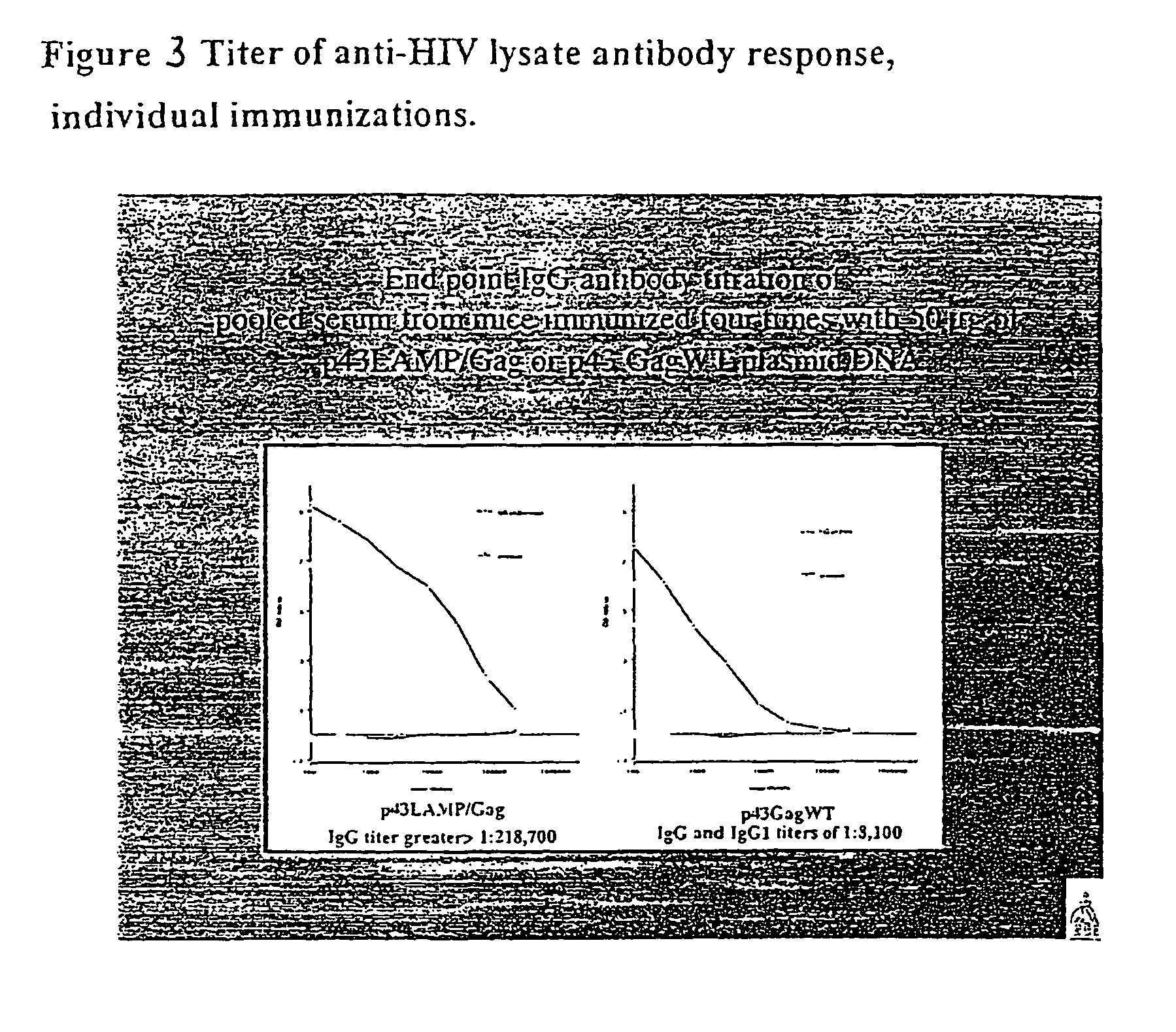Chimeric vaccines
a vaccine and chimeric technology, applied in the field of chimeric vaccines, can solve the problems of reduced infectivity, inadequate protection from vaccination, and risk of vaccine introduction
- Summary
- Abstract
- Description
- Claims
- Application Information
AI Technical Summary
Problems solved by technology
Method used
Image
Examples
example 1
High Level Expression HIV-1 Gag In Vitro by Plasmids Containing Antigen Inserted into the Full Lamp Sequences and the Adeno Associated Virus Inverted Terminal Repeat Sequences
[0283]A number of different nucleic acid constructs were constructed encoding chimeric vaccines.
[0284]A plasmid capable of eliciting a high level of Gag expression as a fusion protein with LAMP in transfected cells is shown in FIG. 1. Gag expression by this plasmid is compared to that of a number of other plasmid constructs in the figure. For example, Plasmid 1 comprises the wild type [HIV-1] Gag gene in the pcDNA3.1 (Invitrogen) vector backbone. Plasmid 2 comprises a gag chimera containing LAMP signal sequence, transmembrane and cytoplasmic domains, in pcDNA3.1. Plasmid 3 comprises a chimera with Gag inserted between the lumenal and transmembrane / cytoplasmic domains of the complete LAMP cDNA in pcDNA3.1. Plasmid 4 shows HIVGagΔINS15 containing mutations of the Gag inhibitory sequences in pcDNA3.1. Plasmid 5 co...
example 2
Evaluation of the Immune Response of Mice to Plasmids Encoding a Complete LAMP / HIV-1 Gag Chimera Protein
[0287]High level expression in transfected cells of Gag protein as a chimera of approximately 200 kDa (assayed by anti-Gag antibodies) was found to result from insertion of the HIV-1 p55Gag sequence downstream of the coding sequence of the LAMP lumenal domain (1113 bp) (FIG. 7E construct #3). Moreover Gag expression was further markedly amplified by including AAV ITRs into the expression vector. Approximately 40-fold greater expression was observed for this construct than for a LAMP / Gag construct without such sequences as determined by densitometry. This expression was 200-fold greater than the expression of wild type Gag (FIG. 7E construct #7). There was minimal Gag protein expression in transfected cells with plasmids that lacked the LAMP lumenal domain, even in plasmids containing the ITR (FIG. 7E, constructs #1, 2, 6). Thus, the high level expression of Gag required the lumena...
example 3
Further Evaluation of the Immune Response of Mice to HIV-1 Gag Encoded as a Full Length Lamp Chimera in the p43 Plasmid Vector; a Repeat Study and Additional Controls
[0296]Groups of 6 mice were immunized with 50 μg of DNA at the base of the tail on days 0 and 30 with the plasmid constructs as below. Blood samples were obtained on days-1, 29, and 45, and half of the mice sacrificed on day 45. The primary goal of this experiment, was to confirm the initial result of the p43(AAV-ITR) LAMP / Gag / TMCD plasmid and to include additional control immunizations. A number of different constructs were evaluated: 1) p43 (AAV-ITR) (plasmid negative control); 2) p43 (AAV-ITR) LAMP (LAMP negative control without gag); 3) p43 (AAV-ITR) wild type Gag; 4) p43 (AAV-ITR) lumenal domain of LAMP / Gag / LAMP transmembrane and cytoplasmic domains; 5) pVax wild type Gag; and 6) pVax lumenal domain of LAMP / Gag / LAMP transmembrane and cytoplasmic domains.
[0297]The anti-HIV specific antibody response at day 29 after ...
PUM
| Property | Measurement | Unit |
|---|---|---|
| size | aaaaa | aaaaa |
| size | aaaaa | aaaaa |
| hydrophobic | aaaaa | aaaaa |
Abstract
Description
Claims
Application Information
 Login to View More
Login to View More - R&D
- Intellectual Property
- Life Sciences
- Materials
- Tech Scout
- Unparalleled Data Quality
- Higher Quality Content
- 60% Fewer Hallucinations
Browse by: Latest US Patents, China's latest patents, Technical Efficacy Thesaurus, Application Domain, Technology Topic, Popular Technical Reports.
© 2025 PatSnap. All rights reserved.Legal|Privacy policy|Modern Slavery Act Transparency Statement|Sitemap|About US| Contact US: help@patsnap.com



